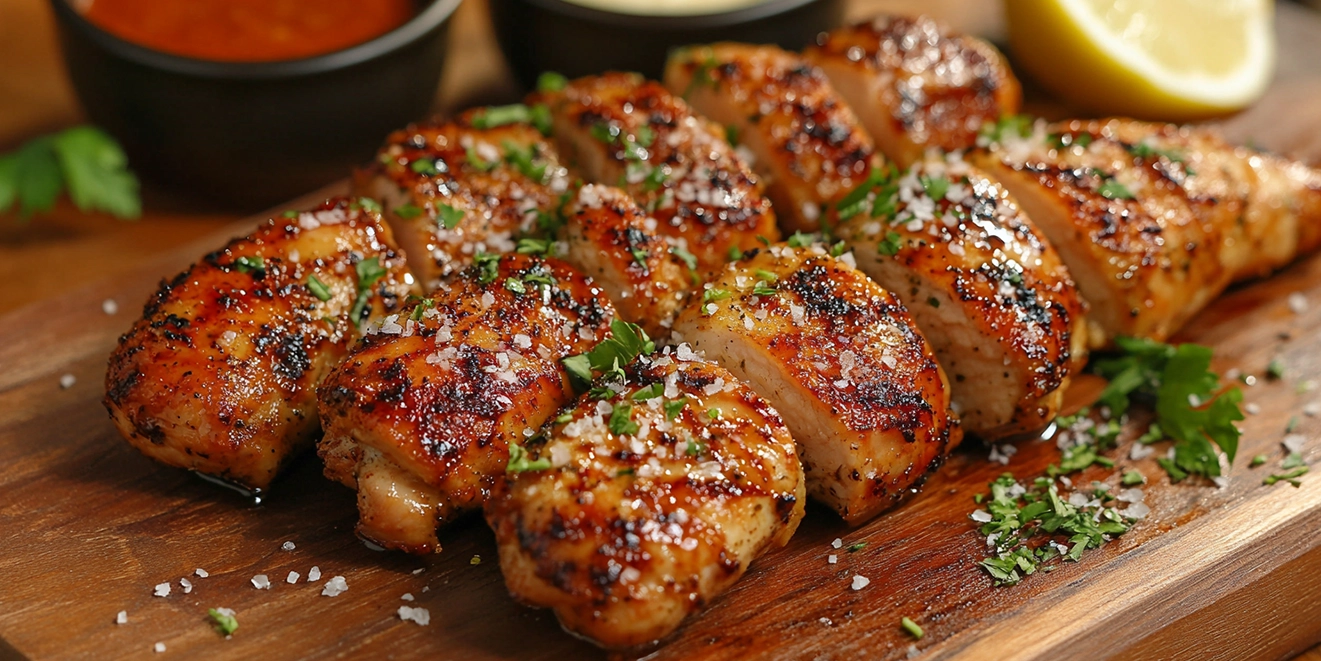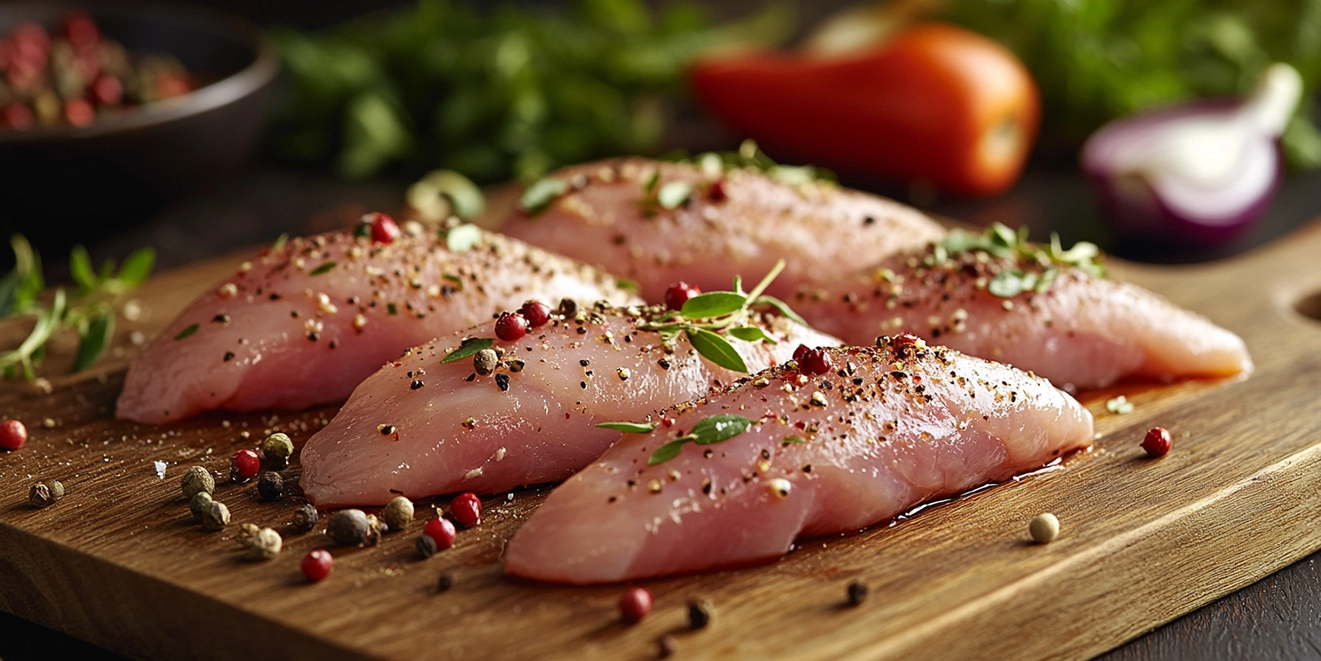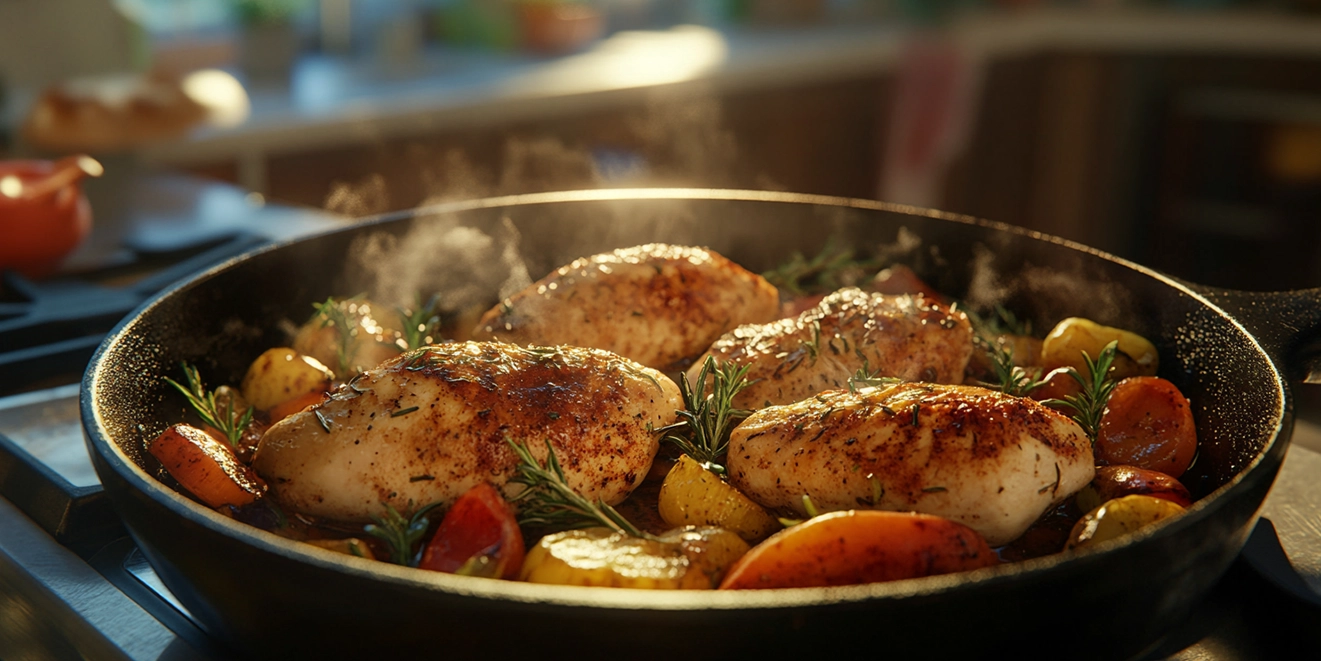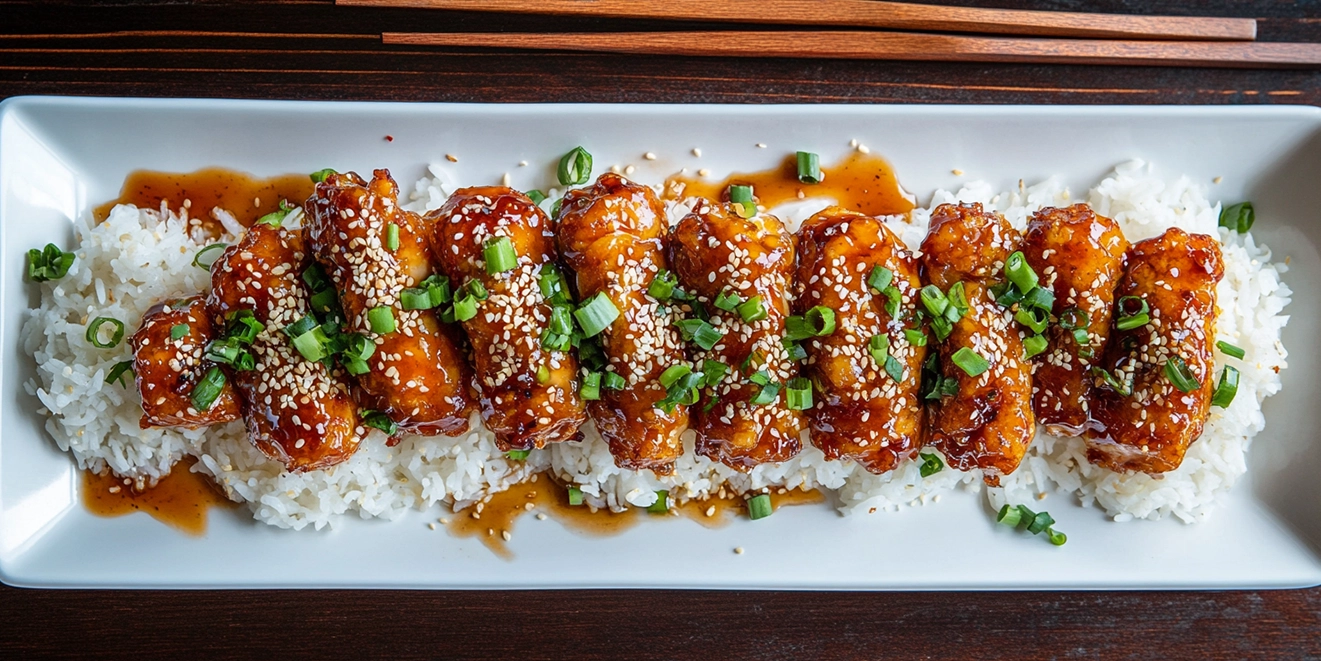
Table of Contents
Introduction
Chicken Tenderloins is one of the most versatile and widely consumed proteins in the world. Whether preparing a quick weeknight dinner or a gourmet feast, understanding the various cuts of chicken can elevate your cooking to new levels. Each cut offers unique characteristics, flavors, and cooking methods, making it essential for home cooks and professional chefs alike to know their options.
Overview of Chicken Cuts
Chicken is typically divided into several primary cuts, each with its distinct qualities and culinary applications:
- Breast
- The leanest and most tender part, ideal for grilling, sautéing, and baking.
- Often sold boneless and skinless for convenience.
- Thighs
- Known for their rich flavor and juiciness.
- Available bone-in or boneless and are perfect for slow cooking, roasting, or stir-frying.
- Drumsticks
- The leg’s lower part features a mix of dark meat and connective tissue.
- Best for grilling, frying, or baking.
- Wings
- Popular for appetizers and snacks, often served fried or coated in sauces.
- Includes three parts: drumette, flat, and tip.
- Whole Chicken
- Offers the most versatility, allowing for roasting or breaking down into individual cuts.
- Ideal for making stock or cooking multiple dishes from one bird.
- Ground Chicken
- A finely minced form used for burgers, meatballs, and sauces.
- Combines lean and fatty parts for a balanced texture.
Importance of Understanding the Difference
Knowing the differences between chicken cuts is crucial for several reasons:
- Cooking Efficiency: Each cut requires specific preparation methods and cooking times. Choosing the proper cut ensures a perfectly cooked dish.
- Flavor and Texture: Different cuts offer varying levels of tenderness and flavor. Dark meat, such as thighs and drumsticks, is more decadent, while breast meat is milder.
- Cost-Effectiveness: Whole chickens are often more economical, while specific cuts may suit smaller portions or convenience.
- Culinary Creativity: Mastering the use of various cuts enables you to explore a broader range of recipes, cuisines, and presentation styles.
Why Choose Chicken Tenderloins?
Chicken tenderloins are lean, protein-packed, and cook faster than most cuts of chicken. They’re perfect for busy weeknight dinners or healthy meal prep. Their mild flavor makes them ideal for pairing with various spices and sauces.
For creative ways to incorporate chicken into your meals, check out this guide on Chicken Casserole Recipes, which offers delicious casserole ideas that can include tenderloins.
Anatomy of Tenderloins
Chicken tenderloins are part of the pectoralis minor muscle, which lies directly beneath the more significant pectoralis major (chicken breast). These muscles are less active than the bird’s other parts, contributing to their soft, delicate texture. Tenderloins are naturally separated from the primary breast meat by a thin membrane, making them easy to identify and remove.
Key Characteristics
- Tender Texture
- As the name suggests, tenderloins are the most tender part of the chicken due to minimal muscle usage.
- Small and Uniform Size
- Their slender and consistent shape makes them ideal for quick cooking and portion control.
- Mild Flavor
- Like chicken breasts, tenderloins have a neutral flavor, making them a versatile ingredient for various marinades and seasonings.
- Low-Fat Content
- Tenderloins are lean, making them a healthier protein choice.
Common Uses in Cooking
Chicken tenderloins are a versatile ingredient suitable for a wide range of dishes. Here are some popular ways they are used:
- Fried Chicken Tenders
- Coated in breading and fried to crispy perfection, chicken tenders are a classic comfort food and a favorite among kids and adults alike.
- Grilled or Pan-Seared
- Their uniform size makes them easy to grill or sear for a quick and healthy meal.
- Stir-Fries
- Sliced tenderloins cook quickly, which is ideal for stir-fry recipes with vegetables and flavorful sauces.
- Skewers or Kebabs
- Thread onto skewers, marinated and grilled for a tasty appetizer or main course.
- Stuffed or Rolled
- Flattened tenderloins can be stuffed with cheese, herbs, or vegetables and then baked or fried.
- Soups and Stews
- Their tender texture holds up well in broths, adding protein to soups and stews without overpowering the dish.
What Is Chicken Breast?

Chicken breast is one of the most popular cuts of chicken, known for its lean meat, mild flavor, and versatility in cooking. It comes from the pectoral muscles of the chicken and is widely used in various cuisines worldwide. Chicken breasts are typically sold boneless and skinless, but they can also be purchased bone-in and with the skin.
Anatomy of Chicken Breasts
Chicken breasts are the large, meaty portions on either side of the chicken’s breastbone. They are part of the pectoralis, the major muscle responsible for the bird’s wing movement. Chickens do not use these muscles heavily, which contributes to the breast’s tender and soft texture.
- Boneless and Skinless Breasts:
- The most commonly sold version is convenient for quick cooking and easy preparation.
- Bone-In Breasts:
- These include the rib bone and sometimes the skin, adding more flavor and moisture during cooking.
- Split Breasts:
- A single breast, cut in half with bone and skin intact, is often used for roasting or grilling.
Key Characteristics
- Leanness
- Chicken breast is one of the leanest cuts of meat, making it a go-to choice for those looking to reduce fat intake.
- Mild Flavor
- Its neutral taste pairs well with various seasonings, marinades, and sauces.
- Tender Texture
- When cooked properly, chicken breasts are juicy and tender. However, overcooking can make them dry and tough.
- Versatility
- Chicken breasts can be prepared using countless cooking methods, making them a staple in many dishes.
- Nutritional Value
- High in protein and low in fat, chicken breast is a favorite for health-conscious eaters.
Common Uses in Cooking
Chicken breast is incredibly versatile and can be used in various recipes. Here are some common ways to prepare it:
- Grilled Chicken
- Perfect for salads, sandwiches, or served with sides for a healthy meal.
- Baked Chicken
- Often marinated or seasoned, then baked for a flavorful and moist result.
- Sautéed or Pan-Fried
- Quick and easy, chicken breasts are cooked in a skillet with oil, butter, or sauces.
- Stuffed Chicken Breasts
- It is filled with cheese, spinach, or mushrooms, then baked or roasted.
- Chicken Strips or Nuggets
- Sliced into smaller pieces, breaded, and fried for a kid-friendly meal.
- Shredded Chicken
- Cooked and shredded for use in tacos, sandwiches, or soups.
- Chicken Stir-Fry
- Cut into cubes or strips, chicken breast cooks quickly and pairs well with vegetables and stir-fry sauces.
- Poached Chicken
- Gently cooked in water or broth for salads, soups, or healthy recipes.
- Chicken Curry
- Used in various curries around the world, absorbing spices and flavors beautifully.
Want to pair your tenderloins with a spicy kick? Consider making a side inspired by this Chipotle Chicken Recipe.
Nutritional Comparison: Chicken Tenderloins vs. Chicken Breasts
Protein Content
- Chicken Tenderloins:
- Tenderloins are slightly higher in protein per serving compared to chicken breasts. On average, a 3-ounce serving of tenderloins contains about 23-25 grams of protein. This makes them an excellent choice for those looking to increase their protein intake.
- Chicken Breasts:
- Chicken breasts are also protein-rich, with around 24 grams per 3-ounce serving. They are comparable to tenderloins but slightly leaner overall.
Fat and Calorie Differences
- Chicken Tenderloins:
- Tenderloins tend to have a slightly higher fat content than breasts, contributing to their tender texture. Depending on preparation, a 3-ounce serving contains about 2-3 grams of fat and 110-120 calories.
- Chicken Breasts:
- Chicken breasts are leaner, with approximately 1-2 grams of fat and around 100-110 calories per 3-ounce serving. They are often considered the healthier option for those focused on reducing fat intake.
Vitamins and Minerals
Both tenderloins and breasts offer a similar profile of vitamins and minerals, including:
- Vitamin B6: Important for metabolism and brain health.
- Niacin (Vitamin B3): Supports energy production and DNA repair.
- Phosphorus: Essential for bone health.
- Selenium: An antioxidant that supports immune function.
While the differences in micronutrient content are minimal, tenderloins may contain slightly more selenium due to their fatty composition.
Texture and Flavor Profile
Tenderloins Texture
- Tenderloins are exceptionally tender due to their location beneath the breast and limited muscle use.
- They have a soft, delicate texture that stays juicy even with quick cooking.
- The fat content in tenderloins contributes to a slightly more prosperous and forgiving texture, even if slightly overcooked.
Texture of Breasts
- Chicken breasts are firmer and denser than tenderloins.
- They can be tender and juicy when cooked correctly but are more prone to becoming dry and tough if overcooked.
- Breasts provide a meatier bite and work well in recipes where a firmer texture is preferred.
Taste Differences
- Chicken Tenderloins:
- Due to their marginally higher fat content, they have a slightly more prosperous and flavorful taste. They are excellent for dishes that rely on a soft, buttery texture.
- Chicken Breasts:
- They have a mild and neutral flavor, making them highly adaptable to various marinades, seasonings, and sauces. Their leanness provides a clean taste that pairs well with bold spices.
Cooking Techniques: Chicken Tenderloins vs. Chicken Breasts

How to Cook Chicken Tenderloins
Chicken tenderloins are thin, tender, and quick-cooking. Here are the best methods to prepare them:
- Pan-Searing
- Heat a skillet with a bit of oil or butter over medium-high heat.
- Season the tenderloins with salt, pepper, and spices of your choice.
- Cook for 3-4 minutes per side until golden brown and the internal temperature reaches 165°F (74°C).
- Great for salads, wraps, or quick protein-packed meals.
- Baking
- Preheat the oven to 400°F (200°C).
- Arrange tenderloins on a baking sheet, season, and optionally marinate beforehand.
- Bake for 10-15 minutes until fully cooked but still juicy.
- Works well for meal prep or as part of casseroles.
- Grilling
- Marinate the tenderloins for at least 15 minutes to enhance flavor.
- Grill on medium heat for 3-5 minutes per side.
- Perfect for kebabs or as a main dish with grilled veggies.
- Frying
- Coat tenderloins in breadcrumbs or batter for crispy chicken tenders.
- Deep-fry or shallow-fry in hot oil (350°F / 175°C) for 5-7 minutes.
- Serve with dipping sauces for a crowd-pleasing snack.
- Stir-Frying
- Slice into strips and stir-fry with vegetables and sauce over high heat.
- This method is fast and locks in the tenderloins’ juiciness.
Best Methods for Cooking Chicken Breasts
Chicken breasts are thicker and require slightly longer cooking times. These techniques ensure flavorful, moist results:
- Grilling
- Pound the chicken to an even thickness for uniform cooking.
- Marinate for at least 30 minutes to prevent dryness.
- Grill over medium heat for 6-8 minutes per side or until the internal temperature reaches 165°F (74°C).
- Baking
- Preheat the oven to 375°F (190°C).
- Place seasoned chicken breasts on a baking sheet or in a casserole dish.
- Bake for 20-30 minutes, depending on thickness, covering with foil to retain moisture.
- Poaching
- Submerge chicken breasts in simmering water or broth for 15-20 minutes.
- This method is ideal for shredding or slicing salads, soups, and sandwiches.
- Sautéing
- Cook breasts in a skillet over medium-high heat with oil or butter for 6-8 minutes per side.
- Use a meat thermometer to avoid overcooking.
- Stuffing and Roasting
- Butterfly or slice open the chicken breast, stuff with cheese, spinach, or other fillings, and secure with toothpicks.
- Roast at 375°F (190°C) for 25-30 minutes.
For tips on combining baked chicken with hearty sides, explore our resource on Chicken and Broccoli Recipes.
Tips for Maintaining Juiciness
- Marinate
- Marinate chicken in oil-based mixtures with acids like lemon juice or yogurt to tenderize and infuse flavor.
- Do Not Overcook
- Use a meat thermometer to check the internal temperature. Remove from heat as soon as it reaches 165°F (74°C).
- Pound to an Even Thickness
- Use a meat mallet to ensure uniform cooking and avoid dry edges.
- Rest After Cooking
- Let the chicken rest for 5 minutes before slicing to allow the juices to redistribute.
- Cook on Medium Heat
- Avoid high heat that can dry out the surface while leaving the inside undercooked.
- Add Moisture During Cooking
- Baste with butter or pan drippings, or cook in a sauce to retain moisture.
- Use Bone-In, Skin-On Breasts (Optional)
- Cooking with the bone and skin adds flavor and prevents drying out, especially when roasting or grilling.
Expert Tips for Selecting Quality Cuts of Chicken
What to Look for When Buying
Choosing the right chicken cuts ensures better taste, texture, and nutrition. Here’s what to consider:
- Appearance
- Color: Look for chicken with a light pink hue and no signs of discoloration. Avoid cuts that appear gray, pale, or slimy.
- Fat Distribution: Check for small amounts of white fat; it should not be excessive or yellowed.
- No Bruising: Cuts should be clean and free from blemishes or blood spots.
- Smell
- Fresh chicken should have little to no odor. A firm or sour smell indicates spoilage and should be avoided.
- Packaging
- Ensure the packaging is intact, with no tears or leaks.
- Check the sell-by date and opt for the freshest product available.
- Look for minimal liquid in the packaging; excess liquid can indicate poor storage or freezing.
- Texture
- Gently press the chicken; it should feel firm and spring back. Avoid chicken that feels mushy or overly soft.
- Size and Cut Uniformity
- For even cooking, select uniform-sized cuts, especially for dishes requiring precise cooking times (e.g., grilling or frying).
Organic vs. Non-Organic Options
- Organic Chicken
- Raised without synthetic pesticides, antibiotics, or growth hormones.
- Fed an organic, non-GMO diet.
- Often pasture-raised, with better living conditions.
- Pros:
- Free from chemical residues.
- It tends to have a more natural flavor.
- Environmentally friendly farming practices.
- Cons:
- Higher price point.
- Limited availability in some markets.
- Non-Organic Chicken
- It may include conventionally farmed chickens raised with antibiotics or fed non-organic feed.
- Often mass-produced, making it more affordable.
- Pros:
- Widely available and budget-friendly.
- Consistent quality due to standardized farming practices.
- Cons:
- Potential exposure to antibiotics, hormones, or synthetic feed components.
- Less transparency about farming conditions.
Making the Right Choice
- For Health-Conscious Buyers:
- Organic chicken is the better option for those prioritizing natural and chemical-free protein.
- For Budget-Friendly Options:
- Non-organic chicken works well for everyday cooking, especially from reputable brands or local butchers.
- Look for Certifications:
- USDA Organic, Free-Range, or Certified Humane labels indicate higher quality and ethical farming practices.
- Fresh vs. Frozen:
- Fresh chicken is ideal for immediate use, but frozen chicken can be equally nutritious and convenient when stored properly.
- Local Sourcing:
- Consider buying from local farmers or markets to ensure fresh, ethically raised chicken while supporting small-scale producers.

FAQs: Chicken Tenderloins vs. Chicken Breasts
Are chicken tenderloins better than chicken breasts?
- It depends on your preference and recipe.
- Tenderloins: Known for their extra tenderness and slightly richer flavor, they cook quickly and are ideal for recipes where soft texture is desired (e.g., stir-fries, fried tenders).
- Breasts: Leaner and larger, breasts are more versatile for grilling, baking, and stuffing and better suited for dishes requiring firmer texture.
Can I substitute chicken tenderloins for chicken breasts?
- Yes, chicken tenderloins can be substituted for chicken breasts in most recipes. However:
- Adjust cooking times: Tenderloins cook faster due to their smaller size and tender texture, so reduce cooking time to avoid overcooking.
- Texture consideration: In recipes where a firmer texture is essential (e.g., stuffed chicken), chicken breasts might be the better choice.
Are chicken tenders just cut-up chicken breasts?
- Not exactly.
- Chicken Tenders (or Tenderloins): A distinct part of the chicken located under the breast. They are naturally smaller, thinner, and more tender than breast meat.
- While chicken breast can be sliced into strips and used as “tenders,” true chicken tenderloins come from a specific muscle with a different texture.
What’s the difference between chicken fillet and chicken breast?
- Chicken Breast: Refers to the whole breast portion, typically boneless and skinless, but it can also include bone-in versions.
- Chicken Fillet: Usually refers to a portion of the chicken breast sliced thinly for quicker cooking. Fillets are often cut from chicken breasts to create uniform, flat pieces for grilling or pan-frying.
Conclusion
Recap of Key Differences
- Texture
- Chicken Tenderloins are extra tender and have a softer texture, making them ideal for quick-cooking methods like stir-frying or frying.
- Chicken Breasts: Firm and dense, perfect for grilling, baking, or stuffing.
- Flavor
- Chicken Tenderloins: Slightly richer due to their marginally higher fat content.
- Chicken Breasts: Mild and neutral, ideal for bold marinades and spices.
- Size and Cooking Time
- Chicken Tenderloins: Smaller and cook faster.
- Chicken Breasts: Larger, requiring more cooking time, and often better suited for recipes needing more significant portions.
- Versatility
- Tenderloins work well in dishes emphasizing tenderness, while breasts are more adaptable to various cooking techniques and textures.
- Nutritional Profile
- Both cuts are high in protein and low in fat, with tenderloins slightly higher in calories and fat.
Final Recommendations for Home Cooks
- Choose Chicken Tenderloins When:
- You need a quick and tender option for stir-fries, fried tenders, or skewers.
- The recipe requires smaller portions or a softer texture.
- Choose Chicken Breasts When:
- Preparing dishes that require firmer meat or more significant portions, such as grilled chicken, stuffed chicken, or baked recipes.
- You want a leaner cut with more slicing, shredding, or dicing flexibility.
- For Cost-Effectiveness:
- Whole chicken breasts are often more economical and versatile. If needed, you can easily cut them into strips to mimic tenderloins.
Explore more recipes and meal ideas at Quicky Cook Recipes, and transform your chicken tenderloins into unforgettable dishes!
